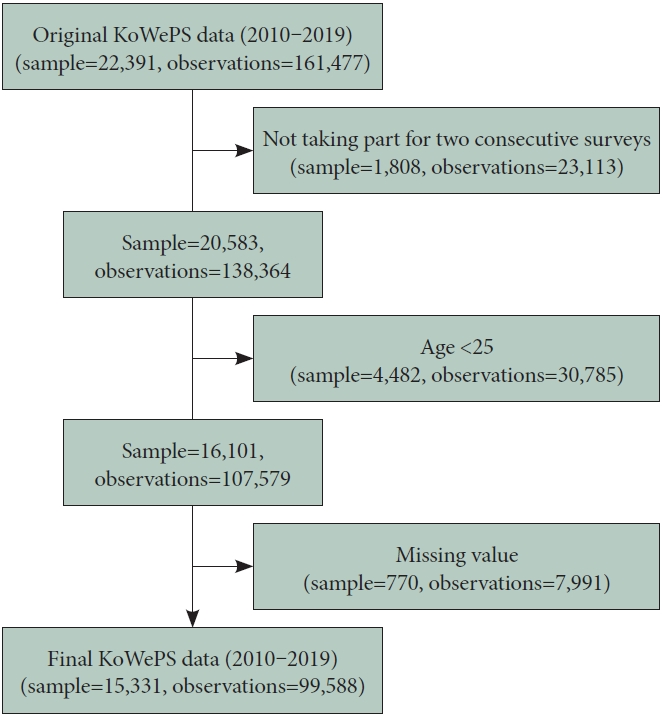2. Blazer DG. Depression in late life: review and commentary. J Gerontol A Biol Sci Med Sci 2003;58:249-265.


3. Smith K. Mental health: a world of depression. Nature 2014;515:180-181.


4. Silva M, Loureiro A, Cardoso G. Social determinants of mental health: a review of the evidence. Eur J Psychiatry 2016;30:259-292.
5. Lorant V, Deliège D, Eaton W, Robert A, Philippot P, Ansseau M. Socioeconomic inequalities in depression: a meta-analysis. Am J Epidemiol 2003;157:98-112.


6. Butterworth P, Rodgers B, Windsor TD. Financial hardship, socioeconomic position and depression: results from the PATH through life survey. Soc Sci Med 2009;69:229-237.


8. Mirowsky J, Ross CE. Age and the effect of economic hardship on depression. J Health Soc Behav 2001;42:132-150.


10. Lewis G, Bebbington P, Brugha T, Farrell M, Gill B, Jenkins R, et al. Socioeconomic status, standard of living, and neurotic disorder. Lancet 1998;352:605-609.


11. Butterworth P, Cherbuin N, Sachdev P, Anstey KJ. The association between financial hardship and amygdala and hippocampal volumes: results from the PATH through life project. Soc Cogn Affect Neurosci 2012;7:548-556.


14. Lorant V, Croux C, Weich S, Deliège D, Mackenbach J, Ansseau M. Depression and socio-economic risk factors: 7-year longitudinal population study. Br J Psychiatry 2007;190:293-298.


17. McKenzie SK, Imlach Gunasekara F, Richardson K, Carter K. Do changes in socioeconomic factors lead to changes in mental health? Findings from three waves of a population based panel study. J Epidemiol Community Health 2014;68:253-260.


18. Frankham C, Richardson T, Maguire N. Psychological factors associated with financial hardship and mental health: a systematic review. Clin Psychol Rev 2020;77:101832


19. Rosenberg M. Rosenberg self-esteem scale (RSE). Acceptance and commitment therapy. Measures Package 1965;61:18
20. Marjanovic Z, Greenglass ER, Fiksenbaum L, De Witte H, Garcia-Santos F, Buchwald P, et al. Evaluation of the financial threat scale (FTS) in four European, non-student samples. J Behav Exp Econ 2015;55:72-80.

21. Ritter C, Hobfoll SE, Lavin J, Cameron RP, Hulsizer MR. Stress, psychosocial resources, and depressive symptomatology during pregnancy in low-income, inner-city women. Health Psychol 2000;19:576-585.


22. Waters L, Muller J. Money or time? Comparing the effects of time structure and financial deprivation on the psychological distress of unemployed adults. Aust J Psychol 2003;55:166-175.


23. Elahi A, McIntyre JC, Hampson C, Bodycote HJ, Sitko K, White RG, et al. Home is where you hang your hat: host town identity, but not hometown identity, protects against mental health symptoms associated with financial stress. J Soc Clin Psychol 2018;37:159-181.

24. OECD. Health at a glance 2021: OECD indicators. Paris: OECD Publishing; 2021.
25. Korean Institute for Health and Social Affairs. User’s guide the 8th wave of the Korean welfare panel study. Sejong: Korean Institute for Health and Social Affairs; 2013.
26. Johnson D. Two‐wave panel analysis: comparing statistical methods for studying the effects of transitions. J Marriage Fam 2005;67:1061-1075.

28. Kim W, Park EC, Lee TH, Kim TH. Effect of working hours and precarious employment on depressive symptoms in South Korean employees: a longitudinal study. Occup Environ Med 2016;73:816-822.


29. Choi M, Lim J, Chang SS, Hwang M, Kim CS, Ki M. Financial hardship and suicide ideation: age and gender difference in a Korean panel study. J Affect Disord 2021;294:889-896.


30. Rosenberg M. Society and the adolescent self-image. Princeton, NJ: Princeton University Press; 2015.
32. Baron RM, Kenny DA. The moderator-mediator variable distinction in social psychological research: conceptual, strategic, and statistical considerations. J Pers Soc Psychol 1986;51:1173-1182.


33. Khang YH, Lynch JW, Yang S, Harper S, Yun SC, Jung-Choi K, et al. The contribution of material, psychosocial, and behavioral factors in explaining educational and occupational mortality inequalities in a nationally representative sample of South Koreans: relative and absolute perspectives. Soc Sci Med 2009;68:858-866.


34. Marmot MG, Bosma H, Hemingway H, Brunner E, Stansfeld S. Contribution of job control and other risk factors to social variations in coronary heart disease incidence. Lancet 1997;350:235-239.


37. Joiner Jr TE. Depression’s vicious scree: self-propagating and erosive processes in depression chronicity. Clin Psychol (New York) 2000;7:203

38. Ottenbreit ND, Dobson KS. Avoidance and depression: the construction of the cognitive-behavioral avoidance scale. Behav Res Ther 2004;42:293-313.


40. Lange C, Byrd M. The relationship between perceptions of financial distress and feelings of psychological well-being in New Zealand university students. Int J Adolesc Youth 1998;7:193-209.

42. Silver L, Van Kessel P, Huang C, Clancy L, Gubbala S. What makes life meaningful? Views from 17 advanced economies. Washington, DC: Pew Research Center; 2021.










